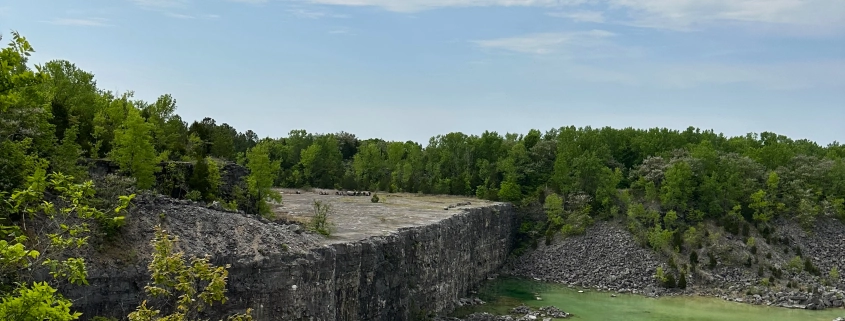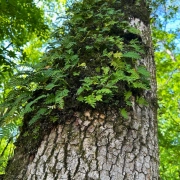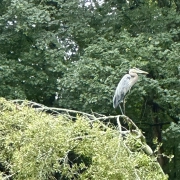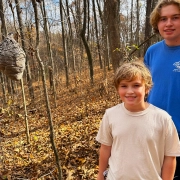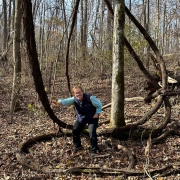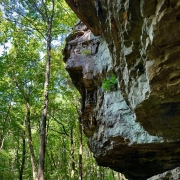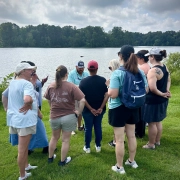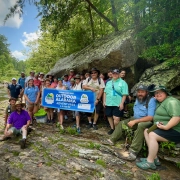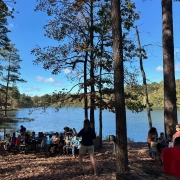Perpetual Wasteland or Future Preserve: Madison, Alabama’s Abandoned Limestone Quarry
My total left knee replacement (January 23, 2024) healed enough by April 26, to allow me to comfortably explore old access roads on Madison, Alabama’s long abandoned limestone quarry, a site proposed by Madison Trails and Greenways (MTG) as a potential Nature Preserve. I snapped photographs and recorded a 60-second video of the old quarry. When I returned home I found excellent photos depicting Nature’s tireless revegetation of the abused and savaged land at the quarry’s periphery. I also discovered that my iPhone had recorded the 60-second video in a 5-minute slow-motion format! I returned on May 28 to record another quarry video, snap a few photos of additional wildflowers, and record a second video of a stripped and vacant operational area on the outlet’s lower slope below the quarry.
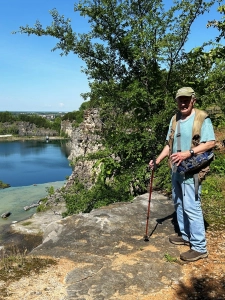
Some of my MTG colleagues view the site’s preserve potential through rose-colored glasses. I visited the property prepared to assess it objectively and dispassionately. Once in my younger professional years, I was directly responsible for my employer’s (Union Camp Corporation) 500 square miles (320,000 acres) of south-central Alabama forestland, a majority untouched by attempted domestication as pasture or cropland, much less stripped of overburden, deeply scarred by quarrying, and with roads, dozing, and cement-dumping across much of the area we traversed. I tried to see the property without bias, yet I admit skepticism regarding categorizing a savaged abused land as a Nature Preserve.
I will attempt to reflect on the quarry in light of a potential refuge in a county rapidly developing with residential, commercial, and industrial expansion. Perhaps a 66 acre property, severely disturbed as it is, can serve a useful role in recreation, conservation, and Nature education and interpretation.
I divided this photo essay into presenting the actual quarry and reflecting on Nature’s attempt to revegetate the abused land, which prior to the quarry cutting and lifting the first block of limestone was a Madison County forested hilltop. Questions I have not answered include:
- Who operated the quarry?
- Beginning when?
- Ending when?
- Quality of the limestone removed?
Fascinating and Colorful Background
My efforts to uncover historic information on the quarry’s operations fell far short of my target.
Instead, I found this undated text from a website on Alabama diving:
Once closed to diving, Madison Quarry, which is best known for its sunken Minuteman Missile, is a fantastic place to visit. Located Southwest of Huntsville and maintained by a shop called Better Divers, this beautiful quarry is surrounded by soaring cliffs and has lots to see underwater, including an F-4 Phantom jet, a titan missile nose cone, houseboats and other boats, a pickup truck, a fire truck, and more. There are lines installed for controlled swimming ascents, plus there is a shallow confined water area for training. Maximum depth is 55 feet, but average depth is just 40 feet. Visibility is normally between 20 and 30 feet, and temperatures are normally in the 70’s during the summer months. You’ll find catfish and grass carp, brim, koi, and bass here, along with the occasional harmless freshwater jellyfish. Topside amenities are numerous, including a snack shop with hot food, changing rooms and restrooms, air fills, and more. Madison Quarry is open on weekends between May 1 through October 31st; if you have a group that wants to dive on a weekday, you can make an appointment to do so.
And from another website:
Rock Divers Madison Quarry is a shore accessible fresh water dive site, located in Madison, AL. This dive site has an average rating of 3.67 out of 5 from 9 scuba divers. The maximum depth is 31-35ft/9-11m. The average visibility is 11-15ft/3-5m. This dive site provides bathrooms and airfills. Training platforms are available.
Madison Alabama – The city owns it and there’s a guy who leases it and charges to dive there.
Water visibility varies from 20 to 40 feet depending upon “new” divers in the water and rainfall. Water temperature is usually hovers between mid 60’s and 70’s year round with a normal low in winter of 50 to a high of 85 in the summer. The Park has a Full Service Dive Shop offering SCUBA classes, equipment rental, air, and equipment sales. Facilities include underwater training platforms, a 30-foot houseboat, 36 foot-long steel bridge, 30 foot NASA Space Station Module, and other sunken relics such as various NASA hardware, a City of Madison Truck, numerous smaller boats and a U. S. Air Force F4 Fighter.
My April 26 and May 28, 2024 Visits
The green-shaded area below my perch 70 feet above is shallow water tinted with algae and sediment. The 30-35-foot deeper water appears nearly black in the image at right. The immediate foreground and at least an acre on this side of the rim area, including portions of the access roads, seems to have served as a dumping area for cement trucks left at the end of a shift with cement not distributed on a delivery site. The site reminds me of hardened lava overflow near a volcano, Nature’s example of severe disturbance. Importantly, Nature has limitless time; she’s in no hurry to develop a Nature Preserve in a north Alabama urbanizing environment.
I see safety hazards wherever my eyes roam. Granted, the Grand Canyon presents precipitous overlooks where visitors could tumble thousands of feet. The chain link fence along the quarry perimeter is there for a reason. What is the cost of protecting visitors and indemnifying the City or MGT?
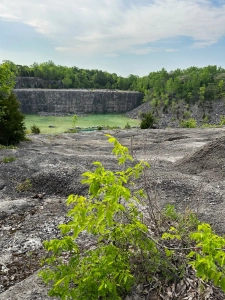
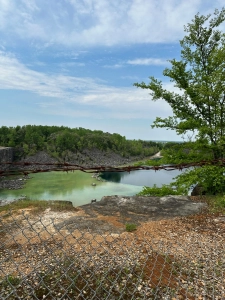
I must admit that the quarry is oddly hypnotizing with its diving days halcyon history and its exotic beauty.
Here is my May 28, 60-second video:
I found a better overlook viewpoint during our May perimeter circuit. You may think I crossed over a damaged part of the perimeter fence to get an unobstructed perspective. Those of you who know me would not accuse me of such ill-advised behavior!
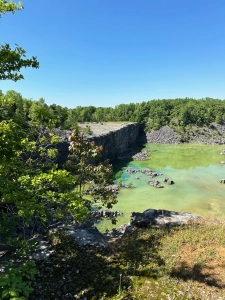
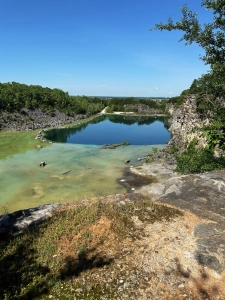
Nor would you expect such a thing from Brian Conway, a fellow MGT Board member.
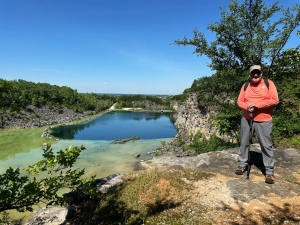
The north rim access road leads to a communication tower. Power lines service the tower. Picture this road as one of the hiking trails. See the perimeter fence to the right. Yes, that’s the perimeter fence that Brian and I did not violate!
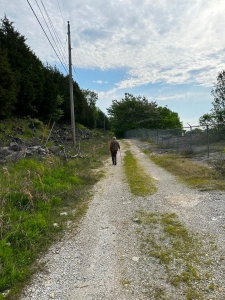
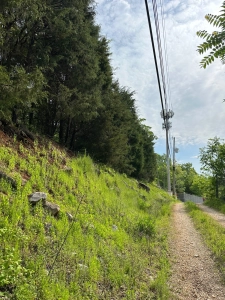
The microwave tower lends a space age dimension to the ancient quarry.
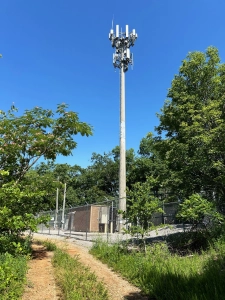
Nature’s Healing Ways
Although the quarry struck me as a curiosity, a relic of man’s dependence on Nature and her diverse natural resources, I focused both excursions on Nature’s efforts to heal wounds. Nature does abhor a vacuum, her relentless attempt to revegetate abused land as an example.
Decades ago quarry operators lined the access road with a levy of boulders opposite the quarry edge. Eastern red cedar, a classic pioneer species, colonized the berm above the road. Birds consume the cedar fruits; their digestive juices scarify the seed coat; the birds dutifully deposits the seeds during their rounds, in this case in brush along the road.
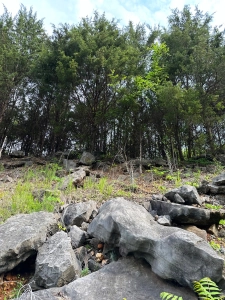
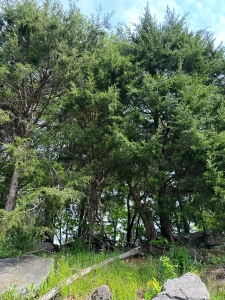
Princess tree, Paulownia tomentosa, is a pioneer invasive (Asian), adept at colonizing edge habitat. The species showcased its blue flowers during the April visit.
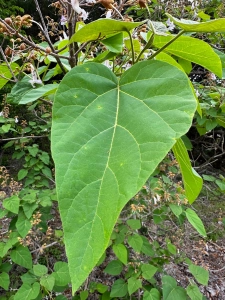
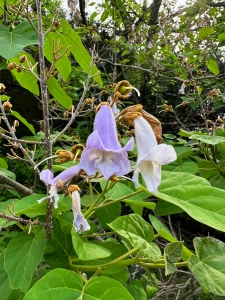
The April Flowers had transformed to green seed pods by the end of May. I discovered a discarded stem of last year’s seed pods (right). Pioneer species are adept at prodigious seed production, effective seed dispersal, and a demand for germination and growth dependent upon full sunshine.

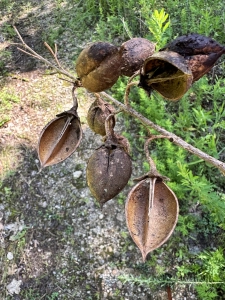
Tree of heaven is yet another invasive early stage successional tree species, an exceptionally fast grower that colonizes readily, grows rapidly, and eventually yields occupied sites to longer lived forest species, i.e. later stage successional tree species such as oak and hickory.
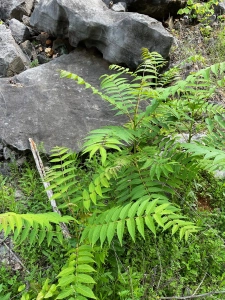
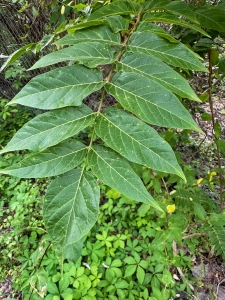
I found lots of smooth sumac securing purchase on these bruised and battered quarry-proximate sites. This is yet another early successional species specializing in invading disturbed sites, living robustly over their relatively short life, and passing the forest gavel to the next successional cohort. Like other such species, smooth sumac produces large quantities of fleshy seeds, attracting birds that consume the fruit, digestively scarify tough seedcoats, and distribute the seeds to other disturbed sites within their range.
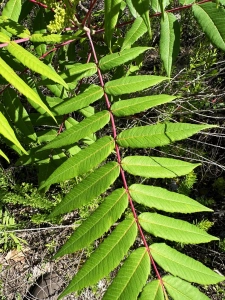
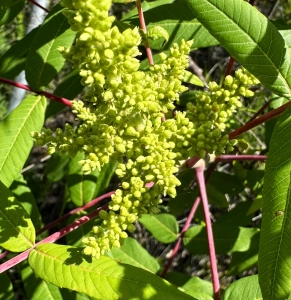
Anyone who roams northern Alabama during early spring can attest to the widely distributed species (with red blossoms) that flourishes at the forest edge along our byways and across abandoned pastures and meadows. Redbud and service berry (white flowers) may be the most recognized spring wildflowers across the eastern US.
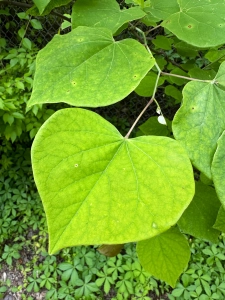
Trumpet vine is another first-rank colonizer common along the perimeter road.
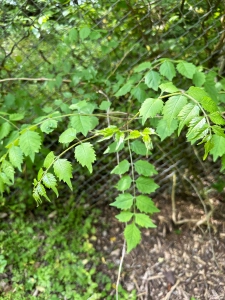
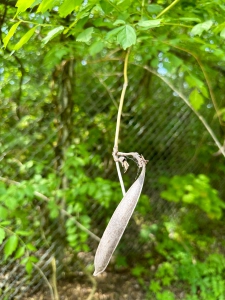
The lovely trumpet flowers greeted me during my May return visit.
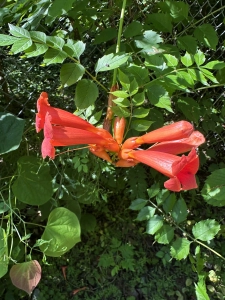
Virginia creeper vine clung to a section of the perimeter fence.
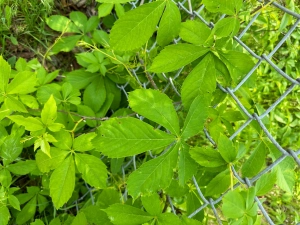
Box elder and green ash likewise joined in reclaiming a sense of wildness among the ruins.
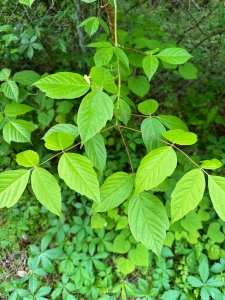
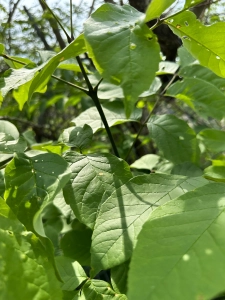
Elderberry flower clusters enhanced the natural beauty of its own accord without the intentional assistance of man, who merely ravaged the formal hilltop, operated the quarry, and walked away, abandoning the site and allowing Nature to do her thing. Eons of evolution have prepared Nature to remediate, recolonize, and reforest areas savaged by fire, wind, volcano, landslide, meteoric blasts, and other acts of God (and man).
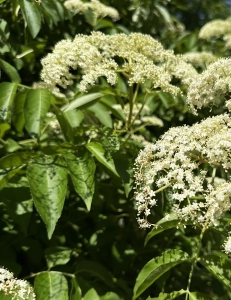
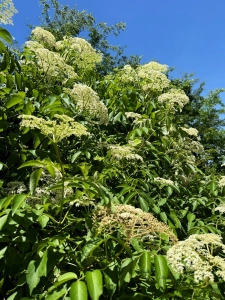
Winged elm is among the woody species playing a role in reclamation.
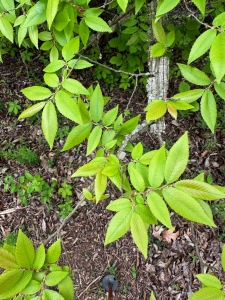
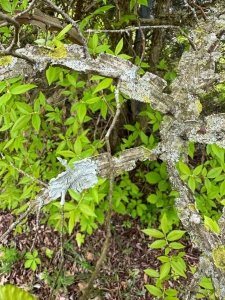
Mimosa, another Asian plant invasive, welcomed me in May with delicate flowers.
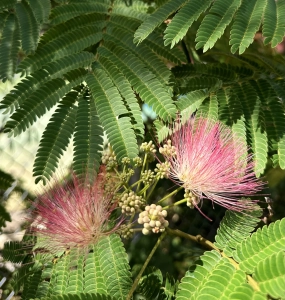
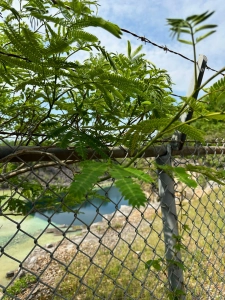
Fragrant sumac, a species that looks enough like poison oak to ward off many humans, presents fresh leaves and a few residual berries from last summer’s crop.
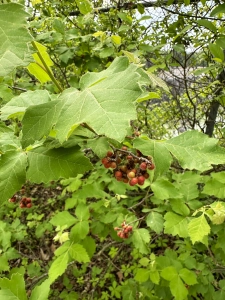
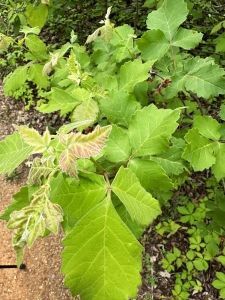
My old friend (NOT!), Chinese privet, found a foothold, grew aggressively, flowered prodigiously, and will produce heavy seed crops to attract birds and ensure seed dispersal and distribution.
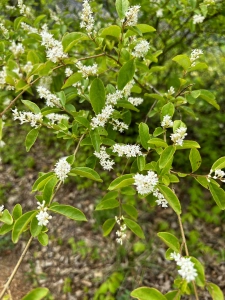
On a much brighter note, lespedeza (a native genus) is growing along the perimeter road. Lespedeza’s roots sport nitrogen fixing bacteria which draw nitrogen from the atmosphere and enrich the soil where they are rooted, just another natural mechanism for remediating barren, scarred, and abused land.
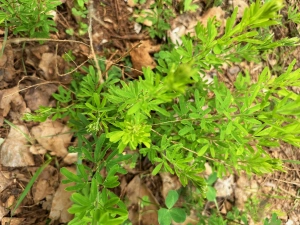
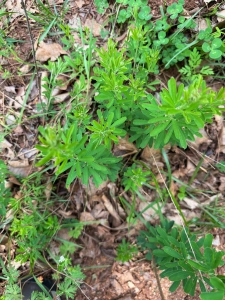
A Relevant Sidebar on DEI
I want to add a time-relevant reflection. We hear so much today about DEI — Diversity, Equity, and Inclusion, a social construct that has no parallel in Nature. Nature is a strict meritocracy that is reclaiming Madison Quarry without regard to DEI. The plant community colonizing the area will be diverse based upon species and individual’s merit in taking root and competing effectively on the wide range of environmental conditions. Equity does not exist…only equal opportunity pervades Nature. Merit and performance matter. No one is taking attendance, keeping track, and counting heads. If fragrant sumac and smooth sumac perform, compete, and persevere, they proceed forward in time and succession. Inclusion is determined strictly by performance. Nature doesn’t check a box, keep a tally, or guarantee a role. Again, merit and performance matter.
See my 2021 photo essay elaborating on the theme of Nature As a Meritocracy: https://stevejonesgbh.com/2021/09/21/lessons-from-nature-nature-is-a-meritocracy/
June 15, 2024, Scale AI CEO Aledandr Wang announced that his company will hire not for DEI, but for MEI: Merit, Excellence, and Intelligence.
Like Nature, America’s founding was based on merit and performance, serving us well for 250 years. Capitalism likewise is performance-based. Nature rewards merit, weeds out non-performers, and succeeds according to her own rules. I can only imagine how pitifully and imperfectly a governmental “task force” would revegetate the Madison Quarry.
Harsh Ruins of Stark Beauty and Haunting Promise
Muir: Earth has no sorrow that Earth cannot heal.
I contemplate the quarry with mixed feelings. I’m taken with its stark and haunting beauty and mystery. Its story is rich with lessons:
- Man’s absolute dependence on natural resources
- Our careless disregard for the consequences of our actions
- Nature’s inherent skill in healing wounds through natural processes
- The relentless and seeming disjointed regional development that leads us through desperation to reclaiming a savaged relic of abused wasteland as a Nature Preserve
I contrast this fenced harsh landscape (moonscape) to the 500 square miles of fertile, undisturbed forest I managed in south-central Alabama from 1981-85, and wonder how 40 years later in a relatively wealthy region of north Alabama we are contemplating salvaging a savaged hilltop as a Nature Preserve.
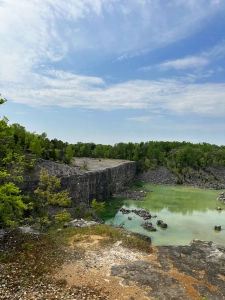
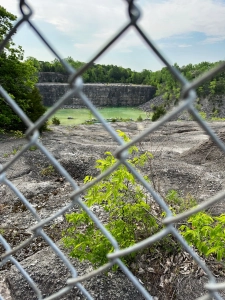
I have not given much focus to a lower elevation corner of the property, leveled decades ago, perhaps employed as a staging area for quarry-related operations. Discarded materiels lie about the clearing. Developed commercial, residential, and industrial development reach beyond the property.
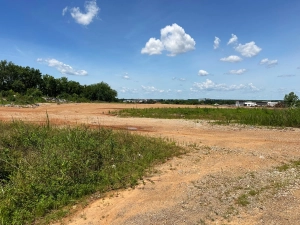
I recorded this 44-second video during my May return visit:
I remain torn about my assessment of the quarry’s future as wasteland or preserve. A lifelong Nature enthusiast, I can see virtue in both possibilities. I need more information. Please view this history-starved assessment as stage one.
Thoughts and Reflections
I offer these observations:
- Earth has no sorrow that Earth cannot heal. (John Muir)
- Often magic lies within Nature’s every nook and cranny; in this case, battered wildness lies crumpled in plain sight.
- Is resurrecting wildness from savage brutality worth the price?
Inhale and absorb Nature’s elixir. May Nature Inspire, Inform, and Reward you!
Note: Unless otherwise noted, all blog post images are created & photographed by Stephen B. Jones. Please circulate images with photo credit: “©2024 Steve Jones, Great Blue Heron LLC. All Rights Reserved.”
Another Note: If you came to this post via a Facebook posting or by another route, please sign up now (no cost… no obligation) to receive my Blog Post email alerts: http://eepurl.com/cKLJdL
And Third: I am available for Nature-Inspired Speaking, Writing, and Consulting — contact me at steve.jones.0524@gmail.com
A reminder of my Personal and Professional Purpose, Passion, and Cause
If only more of us viewed our precious environment through the filters I employ. If only my mission and vision could be multiplied by untold orders of magnitude:
Mission: Employ writing and speaking to educate, inspire, and enable readers and listeners to understand, appreciate, and enjoy Nature… and accept and practice Earth Stewardship.
Vision:
- People of all ages will pay greater attention to and engage more regularly with Nature… and will accept and practice informed and responsible Earth Stewardship.
- They will see their relationship to our natural world with new eyes… and understand their Earth home more clearly.
Tagline/Motto: Steve (Great Blue Heron) encourages and seeks a better tomorrow through Nature-Inspired Living!
Steve’s Three Books
I wrote my books Nature Based Leadership (2016), Nature-Inspired Learning and Leading (2017), and Weaned Seals and Snowy Summits: Stories of Passion for Place and Everyday Nature (2019; co-authored with Dr. Jennifer Wilhoit) to encourage all citizens to recognize and appreciate that every lesson for living, learning, serving, and leading is either written indelibly in or is powerfully inspired by Nature.
I began writing books and Posts for several reasons:
- I love hiking and exploring Nature
- I see images I want to (and do) capture with my trusty iPhone camera
- I enjoy explaining those images — an educator at heart
- I don’t play golf!
- I do love writing — it’s the hobby I never needed when my career consumed me
- Judy suggested my writing is in large measure my legacy to our two kids, our five grandkids, and all the unborn generations beyond
- And finally, perhaps my books and Blogs could reach beyond family and touch a few other lives… sow some seeds for the future
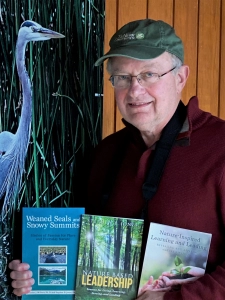

All three of my books (Nature Based Leadership; Nature-Inspired Learning and Leading; Weaned Seals and Snowy Summits) present compilations of personal experiences expressing my (and co-author Dr. Wilhoit for Weaned Seals and Snowy Summits) deep passion for Nature. All three books offer observations and reflections on my relationship with the natural world… and the broader implications for society. Order any from your local indie bookstore, or find them on IndieBound or other online sources such as Amazon and LifeRich.
I now have a fourth book, published by Dutton Land and Cattle Company, Dutton Land & Cattle: A Land Legacy Story. Available for purchase directly from me. Watch for details in a future Post.

